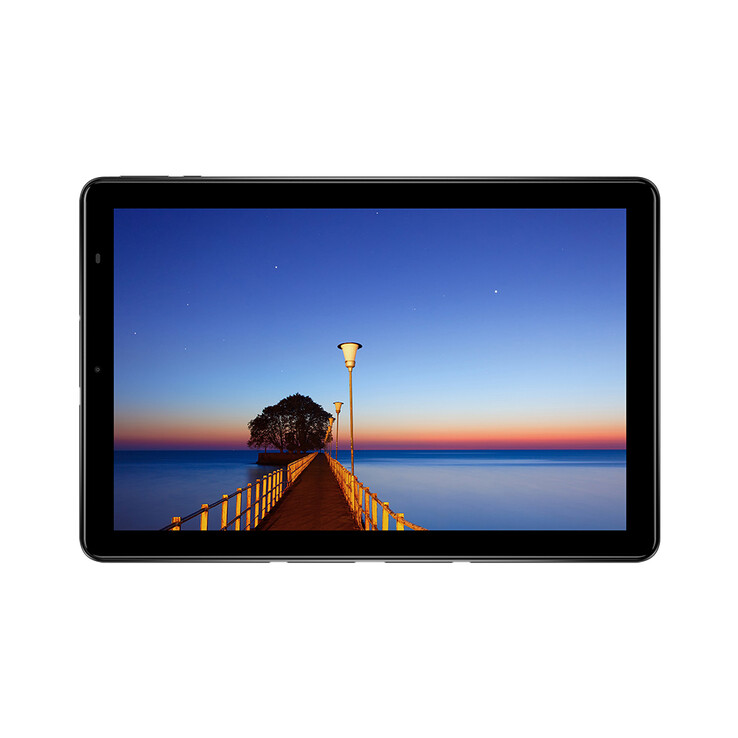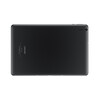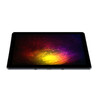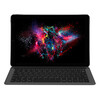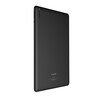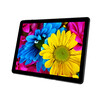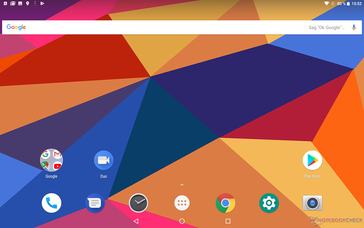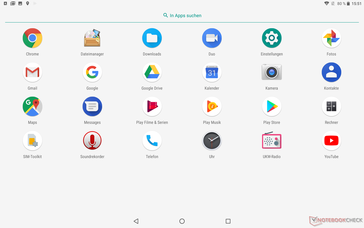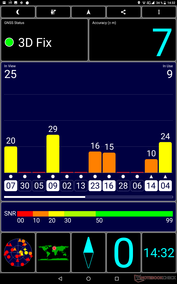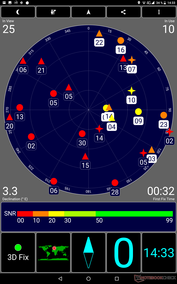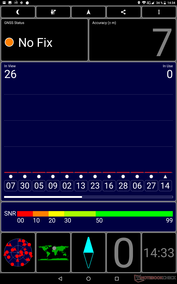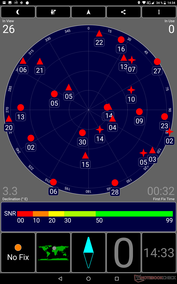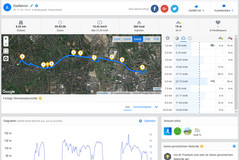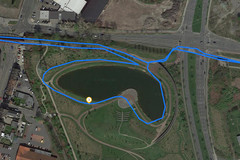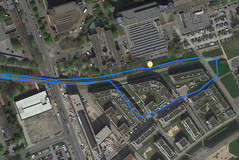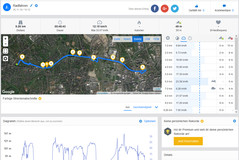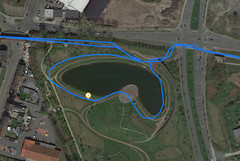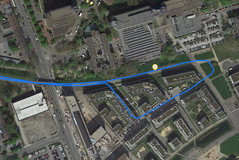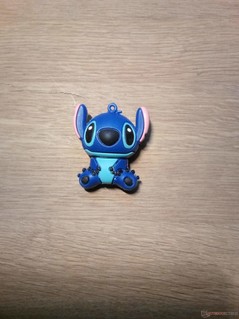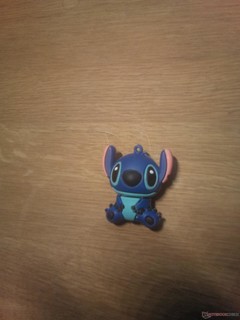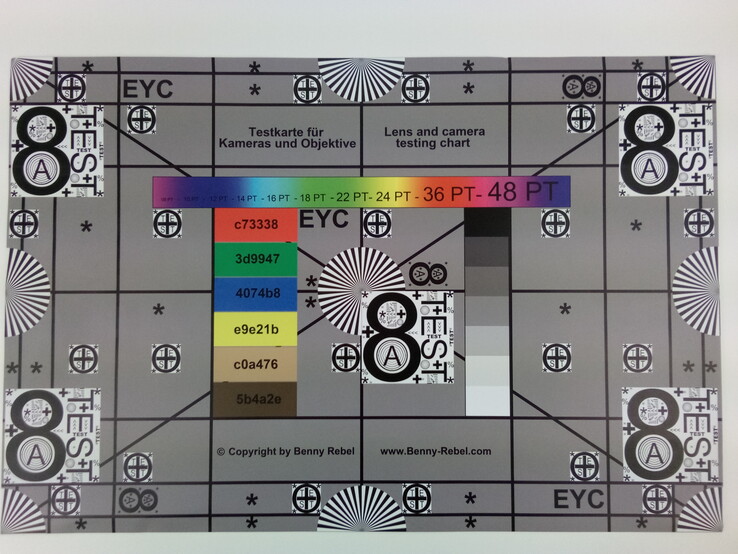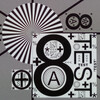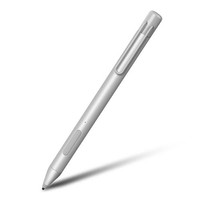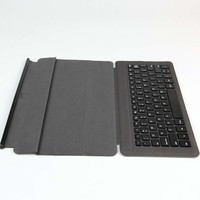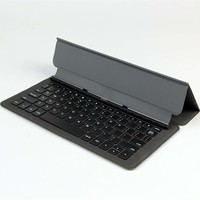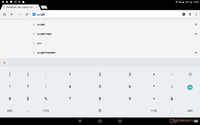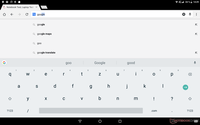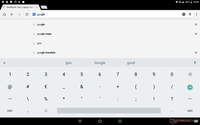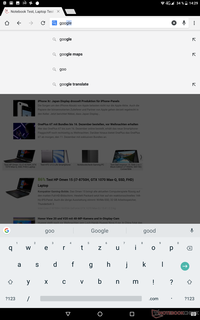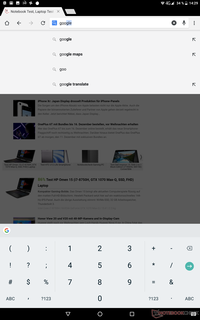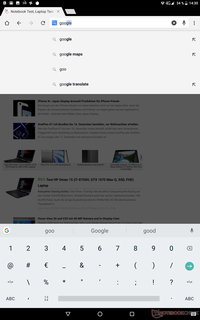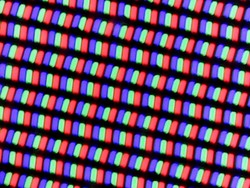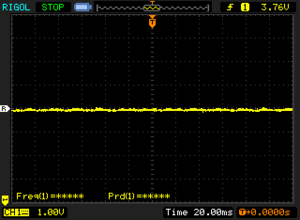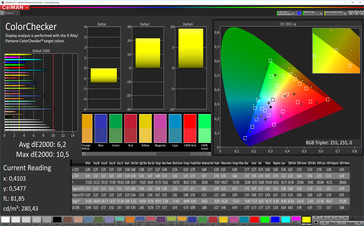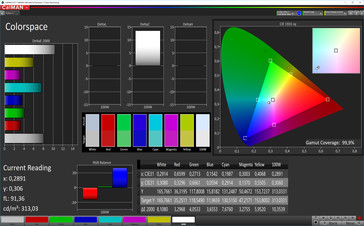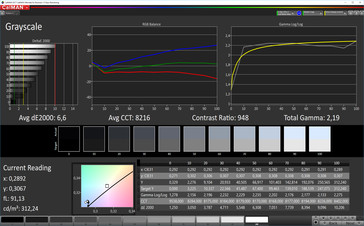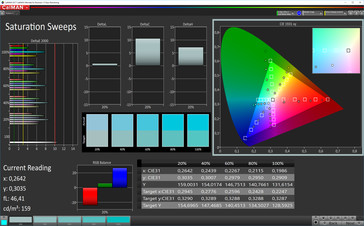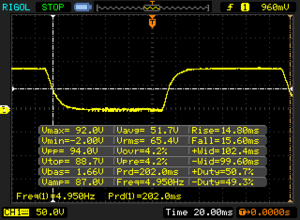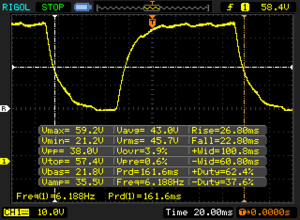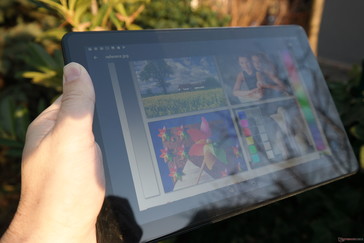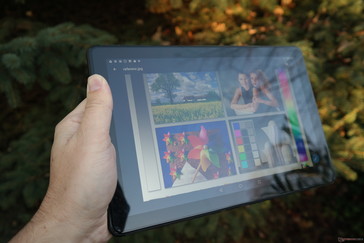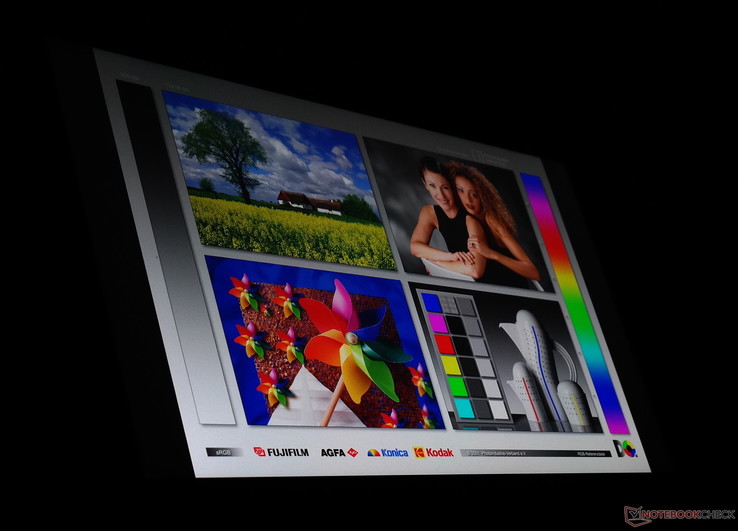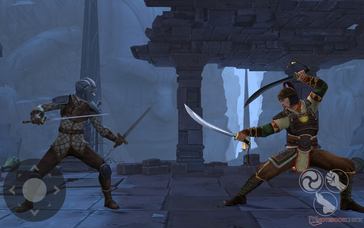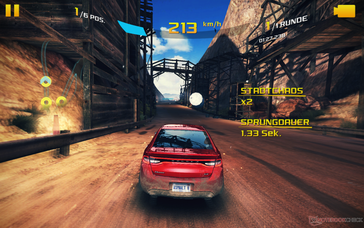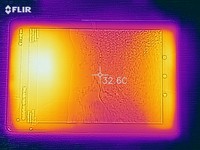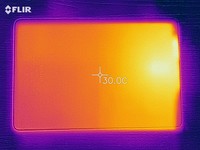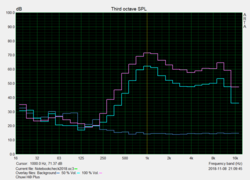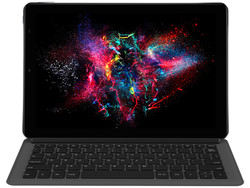Chuwi Hi9 Plus Tablet Review

The Chuwi Hi9 Plus is a tablet that the Chinese manufacturer has equipped with a MediaTek MT6797X SoC, which is better known as the Helio X27. The powerful SoC integrates an ARM Mali-T880 MP4 GPU and is complemented by 4 GB RAM and 64 GB of internal storage. The Hi9 Plus has a bright 10.8-inch IPS display that runs natively at 2560 x 1600 with support for 10-point multi-touch and pen input. The Hi9 Plus also weighs 550 g (~1.2 lb), which is relatively light for such a large tablet.
The device currently retails at US$230, but Chuwi also sells a matching keyboard and pressure sensitive pen that bring the total package up to around US$340. The pricing is undoubtedly impressive, but can the reality match its specifications? Our tests should reveal as much.
We have chosen to compare our test device against the Apple iPad 6 2018, the Huawei MediaPad M5 10.8 Pro and the Samsung Galaxy Tab S4. We will also consider the Hi9 Plus against the Acer Iconia Tab 10, even though the latter does not support pen input.
Case
The Hi9 Plus is well designed, and Chuwi has used pleasing materials that make the device feel sturdy. However, we could still twist the frame and get it to creak, but this is an issue for most large and thin tablets such as seen with the third-generation iPad Pro. We would not have expected the Hi9 Plus to match the iPad 6’s build quality either since the former is a fraction of the cost. It is worth noting that the Hi9 Plus feels more stable than the Iconia Tab 10. Overall, the Hi9 Plus is a pleasantly thin and well-built tablet. Gaps between materials are even and tight on our test device too.
Connectivity
The Helio X27 SoC that powers the Hi9 Plus sits firmly in the middle of the SoCs used in our comparison devices. By contrast, the integrated ARM Mali-T880 MP4 GPU falls behind all but the PowerVR GX6250 of the GPUs in our comparison devices. We shall cover the GPU and SoC in greater detail in the Performance section. The Hi9 Plus has 4 GB RAM and 64 GB of internal storage too, the latter of which can be expanded with up to 128 GB microSD cards. ZDNet reported that the tablet unofficially supports 400 GB microSD cards, but we did not have one on hand to verify its claims. Another highlight of the tablet is its well-lit 10.8-inch display, which has a 2560 x 1600 native resolution.
Chuwi has distributed the ports across the top and left-hand side of the device if you hold it in portrait mode. The headphone jack is on the top edge and is flanked by the USB 2.0 Type-C port to its left and the card slot to its right. There are also a set of Pogo pins on the right-hand side to connect the optional keyboard cover and two slots that it uses for added stability. Chuwi has placed the power and volume buttons on the opposite side, below which also sits a microphone.
Software
The Hi9 Plus ships with Android 8.0 Oreo at the time of writing, while our test device has June 2018 Android Security patches installed, which were around six months old at the time of testing. Chuwi has left the OS unchanged from stock Android except for installing an FM radio app. The only other pre-installed apps are Google apps like Chrome, Duo, Gmail, and Maps, among others. The Hi9 Plus also supports multiple user accounts should you want to create accounts for more than one person or an account for children.
Communication & GPS
The Hi9 Plus supports all modern Wi-Fi standards up to IEEE 802.11 ac and can connect to either 2.4 GHz or 5 GHz networks. There is no MIMO antenna, which limits our test device to around 200 MBit/s in iperf3 Client Wi-Fi tests when connected to our Linksys EA8500 reference router. These speeds put the Hi9 Plus at the bottom of our iperf3 Client (receive) comparison table, but a respectable third in the transmission test ahead of the Iconia Tab 10 and the MediaPad M5 10.8 Pro. Predictably, the iPad 6 2018 and the Galaxy Tab S4 finished well ahead of the Hi9 Plus in these tests, with the iPad averaging over 500 MBit/s in both.
Chuwi has equipped the Hi9 with a 4G LTE module too that one theoretically could use to make phone calls and send texts. However, we would only recommend doing the former over headphones as the tablet is too large to hold up to your ear like a smartphone.
The Chuwi Hi9 Plus uses BeiDou, GLONASS and GPS including A-GPS for location services. The GPS module in our test device left us with a conflicting impression though. We struggled to find a satellite fix indoors using the GPS Test app even when we stood next to a window despite the app showing many satellites to which we should have been able to connect. Conversely, we could find a sat fix with up to 7 meters (~23 ft) accuracy outside, although the signal was weaker than we would have liked. We also took our test device on a bike ride to compare its navigation accuracy against the Garmin Edge 500, a professional navigation device. While we doubt that most people would use such a large tablet for turn-by-turn directions, the Hi9 Plus performed surprisingly well considering its price. The two devices plotted practically identical routes, except that the Hi9 Plus occasionally took slightly wider corners because it retrieved our location more infrequently than the Garmin. The minor inaccuracies resulted in our test device recording a 30-meter (~98 ft) shorter total distance than the Garmin over a 9.26 km (~5.75 m) bike ride, which represents over 99% navigation accuracy.
Overall, the Hi9 Plus is a worthy alternative to a professional navigation device, although its size will probably stop people from using it for even general navigation tasks.
Cameras
As expected, the Hi9 Plus has unimpressive cameras. The front and rear-facing cameras are both 8 MP sensors, so do not expect miracles from the photos that they can produce. Photos taken with the rear-facing camera look washed out and blurry, while colors look duller than they should be. Consequently, the camera cannot reproduce the pattern of the T-shirt that our toy rabbit is wearing in scene 1, unlike our comparison devices. Moreover, our test device’s photo of scene 3 is a mess compared to those taken with our comparison devices. The whole scene is underexposed, colors look muddy, and there is significant image noise. Please keep in mind though that the Apple iPhone XR, Canon EOS 70D, and Huawei P20 Pro are considerably more expensive than the Hi9 Plus, so we did not expect our test device to compete with any of these devices on camera quality. Overall, we have seen worse rear-facing cameras on tablets, and the camera is good enough for quick snapshots, although we suspect that most people would first reach for their smartphones before picking up the Hi9 Plus to take a photo. The front-facing camera is hardly better either, although an 8 MP sensor is good for a sub-US$250 tablet.
The front-facing sensor reproduces colors more strongly than its rear-facing counterpart, although there is noticeably more color noise. Additionally, the sensor only has a fixed focus compared to the autofocus that the rear-facing sensor uses, which makes resulting photos look blurrier than those taken with the main camera. In short, both sensors have their pluses and minuses, although both take passable pictures in daily use. We would have like to see a higher quality front-facing camera though, which would have been useful for making video calls.
We also subjected our test device to further camera tests under controlled lighting conditions. These additional tests confirmed our subjective impressions, with the rear-facing camera doing a poor job at capturing our test chart. The center of the photo looks sharp, but the chart looks increasingly blurry towards the edges of the photo. Moreover, the edges of the chart look washed out, and color noise dominates the entire picture.
The main camera does a respectable job at reproducing some colors like skin tones though. However, gray and white tones are too dark compared to the reference colors as shown by the screenshot of ColorChecker Passport.
Accessories & Warranty
The Hi9 Plus comes with USB Type-A to Type-C cable and a charger. Oddly, we could only charge our test device using USB Type-A to Type-C cables; the device would not recognize USB Type-C to Type-C cables or USB Type-C chargers. Chuwi does not currently sell any other Hi9 Plus specific chargers either.
The company does sell a matching keyboard cover and an active pen. The folio cover does not have an integrated TrackPad, so you must use the TouchPad or an external mouse as input methods instead. The lack of a TrackPad is no bad thing in our opinion though as small TrackPads like the one on the Surface 3 are frustrating to use. Unfortunately, the origami technique that the folio cover uses to create a quasi-kickstand is not that stable, which caused the tablet to slip regularly during our tests.
The keyboard cover currently costs around US$30 online, while third-party companies sell the Chuwi HiPen for US$25. Unfortunately, Chuwi did not supply us with the latter, so we are unable to test how well it works with the tablet.
The Hi9 Plus comes with a one-year manufacturer warranty, but the Warranty section on Chuwi’s website is blank, so we have no idea what warranty terms apply to the tablet or what the returns process is. We would, therefore, suggest buying a reputable third-party warranty applicable in your region. Alternatively, you could buy the tablet on the Chuwi Amazon shop, which would add Amazon warranty coverage.
Please see our Guarantees, Return policies and Warranties FAQ for country-specific information.
Input Devices & Operation
The Hi9 Plus has a 10-point multitouch touchscreen, which accurately reproduced our inputs even at the edges of the display. We did notice a slight delay in the Real Piano app between us touching the display and the piano reacting accordingly, but we doubt that most people would see this latency in daily use. The display also has a slightly resistive finish that is not as glossy as many modern smartphones. The accelerometer worked perfectly throughout testing though.
Chuwi has pre-installed Google Gboard as the default keyboard, which functions just as well as it does on other devices. It is also possible to switch the keyboard for another, like those downloadable from the Google Play Store.
The physical keyboard is more comfortable and faster to type on than using an onscreen keyboard, despite the keys being smaller than those on a traditional external keyboard or a laptop keyboard. The keys have a clear pressure point though, while the spacebar works well even if it is pressed off-center. The Hi9 Plus does not support any form of biometric authentication, so it is only possible to unlock the device using a password, pattern, or PIN. Alternatively, you could set no password at all, but we would recommend against doing so.
Display
The Hi9 Plus has a 10.8-inch display with a 2560 x 1600 native resolution. This puts the tablet in good company with the most expensive of our comparison devices like the Galaxy Tab S4 and the iPad 6 2018. Our test device achieves an average maximum brightness of 297 cd/m² according to X-Rite i1Pro 2, which puts it at the bottom of our comparison table. By contrast, the iPad 6 2018 and the Galaxy Tab S4 average 513 cd/m² and 477 cd/m², respectively. While we would have preferred Chuwi to have equipped the Hi9 Plus with a brighter display, we cannot fault its brightness uniformity. Our test device has a 92% evenly lit display, which is on par with the best of our comparison devices.
Our test device has a 0.29 cd/m² black value too, which helps it achieve a respectable 1,062:1 contrast ratio, although the Iconia Tab 10 has a better ratio than the Hi9 Plus. However, the latter is more contrast-rich than the MediaPad M5 10.8 Pro and the iPad 6 2018, which are both several hundred US dollars more expensive than the Chuwi.
| |||||||||||||||||||||||||
Brightness Distribution: 92 %
Center on Battery: 308 cd/m²
Contrast: 1062:1 (Black: 0.29 cd/m²)
ΔE ColorChecker Calman: 6.2 | ∀{0.5-29.43 Ø4.78}
ΔE Greyscale Calman: 6.6 | ∀{0.09-98 Ø5}
99.9% sRGB (Calman 2D)
Gamma: 2.19
CCT: 8216 K
| Chuwi Hi9 Plus IPS, 2560x1600, 10.8" | Acer Iconia Tab 10 A3-A50 IPS, 1920x1200, 10.1" | Huawei MediaPad M5 10.8 Pro IPS, 2560x1600, 10.8" | Samsung Galaxy Tab S4 Super AMOLED, 2560x1600, 10.5" | Apple iPad 6 2018 IPS, 2048x1536, 9.7" | |
|---|---|---|---|---|---|
| Screen | -14% | -30% | 48% | 32% | |
| Brightness middle (cd/m²) | 308 | 340 10% | 384 25% | 474 54% | 530 72% |
| Brightness (cd/m²) | 297 | 320 8% | 360 21% | 477 61% | 513 73% |
| Brightness Distribution (%) | 92 | 84 -9% | 84 -9% | 91 -1% | 92 0% |
| Black Level * (cd/m²) | 0.29 | 0.19 34% | 0.8 -176% | 0.61 -110% | |
| Contrast (:1) | 1062 | 1789 68% | 480 -55% | 869 -18% | |
| Colorchecker dE 2000 * | 6.2 | 15 -142% | 6.83 -10% | 2.5 60% | 1.2 81% |
| Colorchecker dE 2000 max. * | 10.5 | 22.8 -117% | 12.7 -21% | 5.8 45% | 3.2 70% |
| Greyscale dE 2000 * | 6.6 | 4 39% | 7.5 -14% | 2.1 68% | 1 85% |
| Gamma | 2.19 100% | 2.09 105% | 2.199 100% | 2.08 106% | 2.28 96% |
| CCT | 8216 79% | 6940 94% | 8544 76% | 6281 103% | 6588 99% |
* ... smaller is better
Screen Flickering / PWM (Pulse-Width Modulation)
| Screen flickering / PWM not detected | |||
In comparison: 53 % of all tested devices do not use PWM to dim the display. If PWM was detected, an average of 8111 (minimum: 5 - maximum: 343500) Hz was measured. | |||
Unfortunately, our test device’s display is comparatively color inaccurate. The display reproduces gray tones with a slight blue tint to them and has higher DeltaE deviations than most of our comparison devices. Worse still, there are no display options that could improve the display’s color accuracy or mitigate the blue tint. Overall, the Hi9 Plus has a fantastic display for a sub-US$250 tablet.
Display Response Times
| ↔ Response Time Black to White | ||
|---|---|---|
| 30.4 ms ... rise ↗ and fall ↘ combined | ↗ 14.8 ms rise | |
| ↘ 15.6 ms fall | ||
| The screen shows slow response rates in our tests and will be unsatisfactory for gamers. In comparison, all tested devices range from 0.1 (minimum) to 240 (maximum) ms. » 82 % of all devices are better. This means that the measured response time is worse than the average of all tested devices (20.2 ms). | ||
| ↔ Response Time 50% Grey to 80% Grey | ||
| 49.6 ms ... rise ↗ and fall ↘ combined | ↗ 26.8 ms rise | |
| ↘ 22.8 ms fall | ||
| The screen shows slow response rates in our tests and will be unsatisfactory for gamers. In comparison, all tested devices range from 0.165 (minimum) to 636 (maximum) ms. » 85 % of all devices are better. This means that the measured response time is worse than the average of all tested devices (31.6 ms). | ||
The Hi9 Plus is surprisingly easy to read given its underwhelming maximum luminosity. We suspect that reflections will overpower the display on a sunny summer’s day, so we would recommend finding a spot in the shade if you plan to use the tablet outside during the summer.
Performance
The Hi9 Plus is powered by a MediaTek Helio X27 SoC, a deca-core processor that integrates an ARM Mali-T880 MP4 GPU. The SoC has two Cortex A72 performance cores that can clock up to 2.6 GHz, four Cortex A53 cores that can reach 2 GHz and four power-saving Cortex A53 cores that can boost up to 1.6 GHz. The Helio X27 SoC is more powerful than the MediaTek MT8176 SoC in the Iconia Tab 10, but it often falls well short of the other processors in our comparison tables. The Qualcomm Snapdragon 835 powering the Galaxy Tab S4, for instance, scores almost double in AnTuTu v7 than the Helio X27 SoC. The iPad 6 2018 is better value for money here though, as its Apple A10 Fusion SoC achieved over 50% higher scores in the same benchmark despite the tablet costing just over a hundred US dollars more than the Hi9 Plus.
Our test device does not perform much better in system performance benchmarks like PCMark for Android either. The Hi9 Plus scored 6% less in the Work 2.0 benchmark than the average of Helio X27 powered devices that we have currently tested and a significant 35% less than the Galaxy Tab S4. The Hi9 Plus even scored 16% short of the Iconia Tab 10 in both PCMark benchmarks, which is disappointing.
| PCMark for Android | |
| Work performance score | |
| Samsung Galaxy Tab S4 | |
| Huawei MediaPad M5 10.8 Pro | |
| Acer Iconia Tab 10 A3-A50 | |
| Average MediaTek Helio X27 MT6797X (4922 - 5984, n=4) | |
| Chuwi Hi9 Plus | |
| Work 2.0 performance score | |
| Samsung Galaxy Tab S4 | |
| Huawei MediaPad M5 10.8 Pro | |
| Acer Iconia Tab 10 A3-A50 | |
| Average MediaTek Helio X27 MT6797X (4077 - 4695, n=4) | |
| Chuwi Hi9 Plus | |
| Basemark GPU 1.1 | |
| 1920x1080 Vulkan Medium Offscreen | |
| Samsung Galaxy Tab S4 | |
| Vulkan Medium Native | |
| Samsung Galaxy Tab S4 | |
| 1920x1080 OpenGL Medium Offscreen | |
| Samsung Galaxy Tab S4 | |
| Average MediaTek Helio X27 MT6797X (n=1) | |
| AnTuTu v6 - Total Score | |
| Samsung Galaxy Tab S4 | |
| Huawei MediaPad M5 10.8 Pro | |
| Acer Iconia Tab 10 A3-A50 | |
| Average MediaTek Helio X27 MT6797X (n=1) | |
| AnTuTu v7 - Total Score | |
| Samsung Galaxy Tab S4 | |
| Huawei MediaPad M5 10.8 Pro | |
| Apple iPad 6 2018 | |
| Chuwi Hi9 Plus | |
| Average MediaTek Helio X27 MT6797X (105872 - 110854, n=4) | |
| VRMark - Amber Room | |
| Samsung Galaxy Tab S4 | |
| Average of class Tablet (n=1last 2 years) | |
| Average MediaTek Helio X27 MT6797X (n=1) | |
| Basemark ES 3.1 / Metal - offscreen Overall Score | |
| Average of class Tablet (255 - 5784, n=10, last 2 years) | |
| Apple iPad 6 2018 | |
The Hi9 Plus is well beaten in our browser benchmarks by all our comparison devices too. The iPad 6 2018 scored significantly higher in the benchmarks that we ran on all our comparison devices, but our test device finished at least 32% behind the Iconia Tab 10 in JetStream 1.1, Octane V2 and Mozilla Kraken 1.1.
Subjectively, web browsing on our test device feels snappy. Pages load quickly, and scrolling remained smooth throughout testing.
| JetStream 1.1 - Total Score | |
| Apple iPad 6 2018 (Safari Mobile 11.3) | |
| Samsung Galaxy Tab S4 (Samsung Browser 8.0) | |
| Huawei MediaPad M5 10.8 Pro (Chrome 68.0.3440.91) | |
| Acer Iconia Tab 10 A3-A50 (Browser: Chrome Version 63) | |
| Average MediaTek Helio X27 MT6797X (29.9 - 48.9, n=4) | |
| Chuwi Hi9 Plus (Google Chrome 70) | |
| Octane V2 - Total Score | |
| Average of class Tablet (763 - 138481, n=96, last 2 years) | |
| Apple iPad 6 2018 (Safari Mobile 11.3) | |
| Samsung Galaxy Tab S4 (Samsung Browser 8.0) | |
| Huawei MediaPad M5 10.8 Pro (Chrome 68.0.3440.91) | |
| Acer Iconia Tab 10 A3-A50 (Browser: Chrome Version 63) | |
| Average MediaTek Helio X27 MT6797X (5909 - 9798, n=4) | |
| Chuwi Hi9 Plus (Chrome 70) | |
| Mozilla Kraken 1.1 - Total | |
| Average MediaTek Helio X27 MT6797X (4261 - 9851, n=4) | |
| Chuwi Hi9 Plus (Chrome 70) | |
| Acer Iconia Tab 10 A3-A50 (Browser: Chrome Version 63) | |
| Huawei MediaPad M5 10.8 Pro (Chrome 68.0.3440.91) | |
| Samsung Galaxy Tab S4 (Samsung Browser 8.0) | |
| Average of class Tablet (243 - 27101, n=81, last 2 years) | |
| Apple iPad 6 2018 (Safari Mobile 11.3) | |
| WebXPRT 3 - Overall | |
| Average of class Tablet (39 - 480, n=25, last 2 years) | |
| Apple iPad 6 2018 (Safari Mobile 10) | |
| Samsung Galaxy Tab S4 (Samsung Browser 8.0) | |
| Huawei MediaPad M5 10.8 Pro (Chrome 68.0.3440.91) | |
| WebXPRT 2015 - Overall | |
| Apple iPad 6 2018 (Safari Mobile 11.3) | |
| Samsung Galaxy Tab S4 (Samsung Browser 8.0) | |
| Huawei MediaPad M5 10.8 Pro (Chrome 68.0.3440.91) | |
| Average MediaTek Helio X27 MT6797X (n=1) | |
* ... smaller is better
Chuwi has equipped the Hi9 Plus with 64 GB of eMMC flash storage. We expected devices with faster UFS 2.1 memory like the Galaxy Tab S4 to have higher transfer speeds in AndroBench 3-5, but the storage in our test device is consistently slower than the average for devices with 64 GB of eMMC storage that we have currently tested.
Moreover, our test device has a horrifically slow microSD card reader that is up to four times slower at reading files and at least three times slower at writing files than the readers in our comparison devices. The Hi9 Plus can only read microSD cards that have been formatted in exFAT, which can only handle up to 4 GB files. We doubt that this will become an issue for most people in daily use, but some long 4K videos will exceed that 4 GB ceiling, so it is worth keeping that in mind if you have many large videos stored on a microSD card.
| Chuwi Hi9 Plus | Acer Iconia Tab 10 A3-A50 | Huawei MediaPad M5 10.8 Pro | Samsung Galaxy Tab S4 | Apple iPad 6 2018 | Average 64 GB eMMC Flash | Average of class Tablet | |
|---|---|---|---|---|---|---|---|
| AndroBench 3-5 | 58% | 101% | 209% | 130% | 1139% | ||
| Sequential Read 256KB (MB/s) | 145 | 173.7 20% | 278.6 92% | 741 411% | 277 ? 91% | 1786 ? 1132% | |
| Sequential Write 256KB (MB/s) | 132.5 | 92.4 -30% | 94.1 -29% | 195.8 48% | 178.4 ? 35% | 1334 ? 907% | |
| Random Read 4KB (MB/s) | 42.2 | 13.7 -68% | 27.41 -35% | 142 236% | 60.7 ? 44% | 244 ? 478% | |
| Random Write 4KB (MB/s) | 13.01 | 8.77 -33% | 15.35 18% | 24.43 88% | 33.8 ? 160% | 278 ? 2037% | |
| Sequential Read 256KB SDCard (MB/s) | 21.16 | 80.4 ? 280% | 84.9 ? 301% | 80.1 ? 279% | 77.4 ? 266% | ||
| Sequential Write 256KB SDCard (MB/s) | 20.44 | 56.8 ? 178% | 73.1 ? 258% | 59.1 ? 189% | 58.3 ? 185% |
Games
Graphics are handled by the ARM Mali-T880 MP4 GPU, which is not in the bargain basement of GPUs, but it is also not at the forefront like the Apple A12X Bionic GPU or the Adreno 640. The T880 MP4 is fine for a sub-US$250 tablet in our opinion though. Both Asphalt 9: Legends and Shadow Fight 3 played smoothly at high graphics, so the tablet should cope well with most moderately complex 3D games. We expect that the Hi9 Plus will have enough graphical power to play many games that are released over the next few years, although most of our comparison devices have more powerful and newer GPUs than the Hi9 Plus has.
The accelerometer also worked flawlessly during our gaming tests. Steering in Asphalt 9: Legends with the accelerometer felt accurate and precise.
Emissions
Temperature
Our test device feels cool to the touch when it is idling. The back of the device even stays cool when it is operating under full load, so the Hi9 Plus should never feel hot if you are holding it. The front of the device reaches a maximum of 35.5 °C (95.9 °F), but this is far from what we would consider dangerous or critical surface temperatures.
(+) The maximum temperature on the upper side is 35.8 °C / 96 F, compared to the average of 33.7 °C / 93 F, ranging from 20.7 to 53.2 °C for the class Tablet.
(+) The bottom heats up to a maximum of 31.5 °C / 89 F, compared to the average of 33.2 °C / 92 F
(+) In idle usage, the average temperature for the upper side is 31.4 °C / 89 F, compared to the device average of 30 °C / 86 F.
Speakers
The Hi9 Plus has underwhelming speakers. Its stereo speakers are found on the top of the back case if you are holding the tablet in landscape mode. While the positioning works well for when the keyboard is connected, the speakers are muffled if the tablet lies flat on a table.
Few smartphone or tablet speakers are noteworthy, but the speakers in our test device are worse than 80% of the devices that we have already tested, according to our database. Overall, the speakers sound quiet at maximum volume, while the sound spectrum is dominated by high tones and bass tones are all but missing.
The headphone jack reproduces audio cleanly, but music sounds too dull for our liking. Audio quality is subjective though, so take our impression with a pinch of salt.
Chuwi Hi9 Plus audio analysis
(±) | speaker loudness is average but good (77.2 dB)
Bass 100 - 315 Hz
(-) | nearly no bass - on average 34.3% lower than median
(±) | linearity of bass is average (9.3% delta to prev. frequency)
Mids 400 - 2000 Hz
(±) | higher mids - on average 8.1% higher than median
(±) | linearity of mids is average (11.5% delta to prev. frequency)
Highs 2 - 16 kHz
(+) | balanced highs - only 1.5% away from median
(+) | highs are linear (3.9% delta to prev. frequency)
Overall 100 - 16.000 Hz
(-) | overall sound is not linear (30% difference to median)
Compared to same class
» 89% of all tested devices in this class were better, 2% similar, 9% worse
» The best had a delta of 7%, average was 20%, worst was 129%
Compared to all devices tested
» 88% of all tested devices were better, 3% similar, 9% worse
» The best had a delta of 4%, average was 24%, worst was 134%
Apple iPad 6 2018 audio analysis
(±) | speaker loudness is average but good (75.7 dB)
Bass 100 - 315 Hz
(±) | reduced bass - on average 11.2% lower than median
(±) | linearity of bass is average (11.9% delta to prev. frequency)
Mids 400 - 2000 Hz
(+) | balanced mids - only 1.3% away from median
(+) | mids are linear (5.9% delta to prev. frequency)
Highs 2 - 16 kHz
(+) | balanced highs - only 3.3% away from median
(±) | linearity of highs is average (11% delta to prev. frequency)
Overall 100 - 16.000 Hz
(+) | overall sound is linear (13.3% difference to median)
Compared to same class
» 25% of all tested devices in this class were better, 4% similar, 70% worse
» The best had a delta of 7%, average was 20%, worst was 129%
Compared to all devices tested
» 13% of all tested devices were better, 3% similar, 84% worse
» The best had a delta of 4%, average was 24%, worst was 134%
Power Management
Power Consumption
The Hi9 Plus is a comparatively energy efficient tablet. Our test device consumes a minimum of 2.18 W at idle and a maximum of 12.86 W under load, which helps it finish second in our comparison table to the Galaxy Tab S4. By contrast, the iPad 6 2018 finished 28% behind our test device across all our power consumption tests.
| Off / Standby | |
| Idle | |
| Load |
|
Key:
min: | |
| Chuwi Hi9 Plus 7000 mAh | Acer Iconia Tab 10 A3-A50 6100 mAh | Huawei MediaPad M5 10.8 Pro 7500 mAh | Samsung Galaxy Tab S4 7300 mAh | Apple iPad 6 2018 mAh | |
|---|---|---|---|---|---|
| Power Consumption | -13% | -18% | 30% | -28% | |
| Idle Minimum * (Watt) | 2.18 | 3.21 -47% | 3.3 -51% | 1.76 19% | 2.2 -1% |
| Idle Average * (Watt) | 5.29 | 5.97 -13% | 4.2 21% | 4.22 20% | 7.8 -47% |
| Idle Maximum * (Watt) | 5.37 | 6.19 -15% | 7 -30% | 4.25 21% | 7.9 -47% |
| Load Average * (Watt) | 8.56 | 9.72 -14% | 10.4 -21% | 4.52 47% | 12.6 -47% |
| Load Maximum * (Watt) | 12.86 | 9.97 22% | 13.8 -7% | 7.35 43% | 12.8 -0% |
* ... smaller is better
Battery Life
The Hi9 Plus has a 7,000-mAh battery, which is the average of the battery capacities in our comparison devices. Our comparison table makes for grim reading at first, with the Hi9 Plus finishing at the bottom, overall. However, the main reason for the massive gap to the MediaPad M5 10.8 Pro, the Tab S4 and iPad 6 2018 is because of the Hi9 Plus’ terrible battery life under load. Our test device lasted just 93 minutes under full load, which is several hours short of comparison devices.
By contrast, our test device finished second in our battery life at idle test with a runtime of 20:41 hours, while its 10:34 hours runtime in our Wi-Fi battery life test puts it third behind the MediaPad M5 10.8 Pro and the iPad 6 2018. In short, the Hi9 Plus should last a full day of internet browsing and light tasks, but it will need recharging just 90 minutes into a gaming session. Disappointingly, the 7,000-mAh battery takes almost 5 hours to recharge fully with the included charger.
| Chuwi Hi9 Plus 7000 mAh | Acer Iconia Tab 10 A3-A50 6100 mAh | Huawei MediaPad M5 10.8 Pro 7500 mAh | Samsung Galaxy Tab S4 7300 mAh | Apple iPad 6 2018 mAh | |
|---|---|---|---|---|---|
| Battery runtime | 0% | 46% | 44% | 53% | |
| Reader / Idle (h) | 20.7 | 12.3 -41% | 20.9 1% | 20.5 -1% | |
| WiFi v1.3 (h) | 10.6 | 6.5 -39% | 11.2 6% | 8.3 -22% | 11.9 12% |
| Load (h) | 1.6 | 2.9 81% | 3.7 131% | 4.1 156% | 3.1 94% |
| H.264 (h) | 10.5 | 12.3 |
Pros
Cons
Verdict
Bravo, Chuwi. The Hi9 Plus is a competitively priced and well-built Android tablet that performed well in our tests. It has a fast CPU, a moderate GPU, a decent high-resolution display, and affordably priced accessories. Furthermore, the battery life is on par with the competition for the most part and its Wi-Fi will be fast enough for most home broadband connections. The included LTE module could be convenient in daily use too.
The only downside that we have noticed is the cameras, which are only just passable for video calls and for taking the occasional photo. The lack of manufacturer warranty could eventually become an issue too if you were to drop it, so we could recommend buying the device from a reputable third-party supplier instead.
The Chuwi Hi9 Plus is a fantastic tablet for the money that compromises on little and trades blows with the best current Android and iOS tablets that money can buy.
Overall, the Hi9 Plus is better value for money than our Android-based comparison devices, but the 32 GB iPad 6 offers a more rounded and premium experience for around US$100 more. The Hi9 Plus is the better device if you need or want pen input, but the iPad is more powerful, has a more color accurate and brighter display and is made from more premium materials. In short, the Chuwi Hi9 Plus gets a definite recommendation to buy from us, but we would suggest considering the iPad 6 if you are open to owning a tablet running iOS.
Chuwi Hi9 Plus
- 12/12/2018 v6 (old)
Florian Schaar




